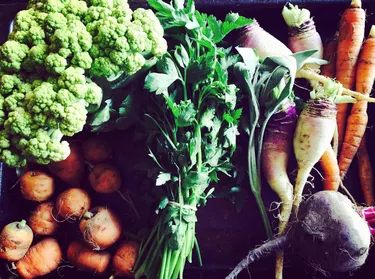The first job I had out of school was at a food market as a PR associate, which mostly meant that I gave tours of the market to visiting media. One day, as I was guiding a journalist through the market's prodigious produce section, she mentioned offhand that the produce was much more varied than what she was getting as a member of a food co-op.
I was curious: During college, I didn't buy a lot of produce because I didn't have the time or energy to cook creatively. I made a lot of pasta, a lot of omelettes, a lot of instant ramen. But a co-op, as the journalist explained to me, was a great way to learn about food as a natural element of our lives. You learned about seasons, how long produce will actually keep, and also got to see things you wouldn't normally try out at the grocery store.
Video of the Day
Video of the Day
With her introduction, I joined a co-op in Los Angeles's Koreatown. The community space has a bountiful vegetable and fruit garden (and chickens!), but every Sunday a truck stops off to unload the leftovers from the morning's farmer's market. This produce varies from bulbs of fennel to endless bushels of carrots to small forests of kale. Over the course of almost three years, I've been confronted with both these familiar things and with produce I'd probably never seek out normally (Rutabagas, anyone?).
Each co-op member opted into receiving a box, which cost $10 per person. For me, I would order a box every time I was on my rotational shift (one Sunday of sorting the incoming produce, every five weeks). I would come home with a bounty of produce, and I had to quickly adapt around the reality of the variety I carried back.
So with that, what's the best way to make the most out of your produce box? Keep in mind that I live in Los Angeles, a region that's almost comically abundant in produce. The depth and breadth of your own local produce co-op will vary, but in general:
Tip
Make an immediate plan for your leafy greens
Lettuce and non-ridged kale in particular will wilt incredibly fast. I take the bus to and from the co-op, so I always pack my leafy greens and other similarly tender produce (e.g. pears) at the top of my bag, so as not to squish them and speed up their wilting process.
Salads are of course fantastic for taking care of greens, but you can also use most greens in sandwiches or stir-fries. And remember: Even if you can't think of a solution, the internet is there for you. Speaking of that...
Tip
Reverse-engineer recipes through internet research
The last time I got a box, I found myself with beets: The red root but also the full bushel of greens. Curious, I started looking into recipes that utilized both beet roots and greens and found one involving (of course) bacon. I already had most of the other ingredients in my pantry, so it wasn't difficult to put it together.
My issue is almost never that I can't think of things to cook with individual ingredients, but that I need some sort of consensus that these combinations are wise. Seeing other recipes out in the wild involving the ingredients I have on hand gives me more ideas about what I can do with my produce — and also prevents me from making bad flavor/ingredient decisions. So instead of searching, say, for general pasta recipes, look up "pasta recipe fennel tomatillo parsley" or whatever combination of produce you're looking to cook, stat.
Tip
Know your root veggies
During the winter season, I'll receive a lot of root produce. Not just carrots, but all of the carrots in the world, plus beets, turnips, rutabagas, cauliflower, and broccoli. While root vegetables will keep a little longer than their leafy counterparts, don't get too comfortable with hiding them away. Once they start to get rubbery, the clock on their expiration ticks away exponentially.
You could store them in (clean) sand to prevent moisture from affecting the roots more, but I personally prefer to just chop 'em up and roast 'em if I don't have time to think too much more about their storage/how well they're keeping. If you have something to puree them, you could also take the roast and turn it into soup.
Two other recipe types that work well for roots: Curry and juice. The latter requires some equipment but if you've got it, that's probably the fastest way to take care of your root produce. (Though you'll definitely have some waste after. Perhaps for composting or bakes?)

Tip
When in doubt, make in bulk
If you have the time to immediately cook and freeze your food, seriously consider this option. Most produce will last for a few days after you store it; but if you'd rather not deal with different expiration timelines, just get it all done at once. You could roast a pan of veggies in the oven while spiralizing zucchini for a pasta alternative, or stir-fry several different kinds of greens with a protein while using the rest in a salad. Herbs in particular can get a lot of mileage in sauces, dressings, roasts, and soups. All you have to do is have an open mind and an empty stomach: You can eat it all, and you absolutely should.